
Grab a Broom (With Me)
2023
Ebonized and natural ash wood, broomcorn, tinned broom wire, epoxy
Brooms are always present and rarely seen. To many, brooms have an interchangeable quality that allows them to hide in plain sight. Their classic, time-tested, and effective form enforces a broom’s utility and, in doing so, relegates them as simple, cheap tools for moving dirt. Just because something touches dirt doesn’t mean it shouldn’t be celebrated.
By tweaking forms and using traditional techniques where they would not normally be used, I have introduced asymmetry, negative space, and angular geometry where the broom would normally be smooth, dense, and even. Biomimicry is integrated as well, as it is in many traditional broom forms such as hawk tails and turkey wings, in this case from insects. The carved details on the broom handle are loosely based on patterns found on insect eggs and long, sharply bent angles of the broomcorn recall spider legs. The stand serves as a familial unifier, allowing the objects to hold hands.

Grab a Broom (With Me)
2023
Ebonized and natural ash wood, broomcorn, tinned broom wire, epoxy
Brooms are always present and rarely seen. To many, brooms have an interchangeable quality that allows them to hide in plain sight. Their classic, time-tested, and effective form enforces a broom’s utility and, in doing so, relegates them as simple, cheap tools for moving dirt. Just because something touches dirt doesn’t mean it shouldn’t be celebrated.By tweaking forms and using traditional techniques where they would not normally be used, I have introduced asymmetry, negative space, and angular geometry where the broom would normally be smooth, dense, and even. Biomimicry is integrated as well, as it is in many traditional broom forms such as hawk tails and turkey wings, in this case from insects. The carved details on the broom handle are loosely based on patterns found on insect eggs and long, sharply bent angles of the broomcorn recall spider legs. The stand serves as a familial unifier, allowing the objects to hold hands.

Hunter L.V. ElliottTrochanter Broom with StandBroom: Broomcorn, tin wire, carved Osage orange nail, hemp chord, red oak, glue Stand: red maple, red oak, Danish oil, walnut pigment, walnut oil, glue2022Available for purchase at Log House Craft Gallery, Berea, KYA main component of my work is allowing material within a piece to be visible. I like to show my process and let the materials speak for themselves. Within most full-sized brooms, many internal components are invisible from the outside. Much goes into the construction of the deceivingly complicated object that is hidden from the user to produce a simple, effective, and functional form. In making this work, I challenged myself to create a broom that pushes the boundaries of what is physically possible with the natural materials traditionally used to make brooms, all while making a striking yet functional piece.By combining different construction tactics that I’ve adapted from commonly used designs in American and Japanese broom making, this broom stands full of intricate details. Its grand scale is broken up by windows of negative space that give the for room to breathe, but also demonstrate the immense tension that the broomcorn was subjected to in order to achieve the bends and pulls that make the shape. From the front view, it resembles a flat plane, with vertical and horizontal arms that weave over and under each other, conjuring an anthropomorphic, insect-like condition. This inspired the title for the piece, Trochanter, referring to the joints in spider’s legs. From the sides,this view is made even more clear by the alternating joints of each bundle, lacing then cascading groundward. Even the innermost core of the broom, an area that is never seen on a Western style broom, can be seen through the edges of the central portion of broomcorn. This broom is unique in the amount of texture it has from every angle. There is hard and soft geometry to be seen regardless of the perspective it is seen from.The broom is bundled and finished in wire, and that wire is finished with a nail, hand carved from Osage heartwood, one of the hardest and most rot resistant woods in North America - unlike the oak handle, which exhibits decay and holes from boring beetles. All the wood featured in the piece was sustainably sourced from the Berea College Forest and campus. The stand which holds the broom is made from red maple, an invasive species in this region. Removal of these saplings was a service to the land by allowing the understory to receive more light and giving slower-growing flora the opportunity to thrive. The symbolic act of using this invasive tree to uphold a rotted limb of an oak subverts this relationship. The stand is stained using walnut pigment, harvested from walnuts from the Berea campus and mixed with a walnut oil base.Brooms hold a special place within humanity. They exist everywhere that humans exist in one form or another, and every population has their own approach to the craft.Brooms appear as symbols in political campaigns and cartoons, as ceremonial objects,as good omens in some cases and bad omens in others. They are thought to strengthen, hurt, or even prevent relationships altogether depending on their use.They have their own etiquette that shifts regionally- when to use them, how to store them, and why. Brooms and their spiritual attributions encapsulate the creation of meaning. That meaning assigned to an inanimate object is reflective of one’s culture,experience, and geographical location. It can seem arbitrary and at times contradictory.Why should something that comes in contact with dirt have a central role in ceremony?The British anthropologist Mary Douglas made famous the phrase “Dirt is matter out of place.” This assertion gives agency to the common derogatory term dirt. Suddenly, dirt isn’t waste, but rather simply material – substance without social connotation. A common theme within many cultures in relation to brooms is their ability to clean,physically, but also spiritually. If Douglas’s perspective shift is applied to these cultural connotations, the broom as a tool to usher away bad luck and to attract good luck makes much more sense. Recognizing that an object means different things in different places erases those superficial contradictions. The broom becomes a neutral vessel. It is a tool capable of exerting force and intention in the direction one chooses. The“matter” either moved or held in this case could be luck, energy, a relationship, a connection to one’s environment, or any other meaning.From a secular perspective, to acknowledge intention, and act in that direction could be a personal ceremony or meditation. I made this broom with environmental concerns and artistic forms in mind - that is my meditation. It allowed me to reflect, and to distill my intentions. It allowed me to create a form and ascribe meaning to it. It allowed me to move some theoretical matter of my own.

Hunter L.V. Elliott
Trochanter Broom with Stand
Broom: Broomcorn, tin wire, carved Osage orange nail, hemp chord, red oak, glue
Stand: red maple, red oak, Danish oil, walnut pigment, walnut oil, glue2022
Available for purchase at Log House Craft Gallery, Berea, KY
A main component of my work is allowing material within a piece to be visible. I like to show my process and let the materials speak for themselves. Within most full-sized brooms, many internal components are invisible from the outside. Much goes into the construction of the deceivingly complicated object that is hidden from the user to produce a simple, effective, and functional form. In making this work, I challenged myself to create a broom that pushes the boundaries of what is physically possible with the natural materials traditionally used to make brooms, all while making a striking yet functional piece.By combining different construction tactics that I’ve adapted from commonly used designs in American and Japanese broom making, this broom stands full of intricate details. Its grand scale is broken up by windows of negative space that give the for room to breathe, but also demonstrate the immense tension that the broomcorn was subjected to in order to achieve the bends and pulls that make the shape. From the front view, it resembles a flat plane, with vertical and horizontal arms that weave over and under each other, conjuring an anthropomorphic, insect-like condition. This inspired the title for the piece, Trochanter, referring to the joints in spider’s legs. From the sides,this view is made even more clear by the alternating joints of each bundle, lacing then cascading groundward. Even the innermost core of the broom, an area that is never seen on a Western style broom, can be seen through the edges of the central portion of broomcorn. This broom is unique in the amount of texture it has from every angle. There is hard and soft geometry to be seen regardless of the perspective it is seen from.The broom is bundled and finished in wire, and that wire is finished with a nail, hand carved from Osage heartwood, one of the hardest and most rot resistant woods in North America - unlike the oak handle, which exhibits decay and holes from boring beetles. All the wood featured in the piece was sustainably sourced from the Berea College Forest and campus. The stand which holds the broom is made from red maple, an invasive species in this region. Removal of these saplings was a service to the land by allowing the understory to receive more light and giving slower-growing flora the opportunity to thrive. The symbolic act of using this invasive tree to uphold a rotted limb of an oak subverts this relationship. The stand is stained using walnut pigment, harvested from walnuts from the Berea campus and mixed with a walnut oil base.Brooms hold a special place within humanity. They exist everywhere that humans exist in one form or another, and every population has their own approach to the craft.Brooms appear as symbols in political campaigns and cartoons, as ceremonial objects,as good omens in some cases and bad omens in others. They are thought to strengthen, hurt, or even prevent relationships altogether depending on their use.They have their own etiquette that shifts regionally- when to use them, how to store them, and why. Brooms and their spiritual attributions encapsulate the creation of meaning. That meaning assigned to an inanimate object is reflective of one’s culture,experience, and geographical location. It can seem arbitrary and at times contradictory.Why should something that comes in contact with dirt have a central role in ceremony?The British anthropologist Mary Douglas made famous the phrase “Dirt is matter out of place.” This assertion gives agency to the common derogatory term dirt. Suddenly, dirt isn’t waste, but rather simply material – substance without social connotation. A common theme within many cultures in relation to brooms is their ability to clean,physically, but also spiritually. If Douglas’s perspective shift is applied to these cultural connotations, the broom as a tool to usher away bad luck and to attract good luck makes much more sense. Recognizing that an object means different things in different places erases those superficial contradictions. The broom becomes a neutral vessel. It is a tool capable of exerting force and intention in the direction one chooses. The“matter” either moved or held in this case could be luck, energy, a relationship, a connection to one’s environment, or any other meaning.From a secular perspective, to acknowledge intention, and act in that direction could be a personal ceremony or meditation. I made this broom with environmental concerns and artistic forms in mind - that is my meditation. It allowed me to reflect, and to distill my intentions. It allowed me to create a form and ascribe meaning to it. It allowed me to move some theoretical matter of my own.
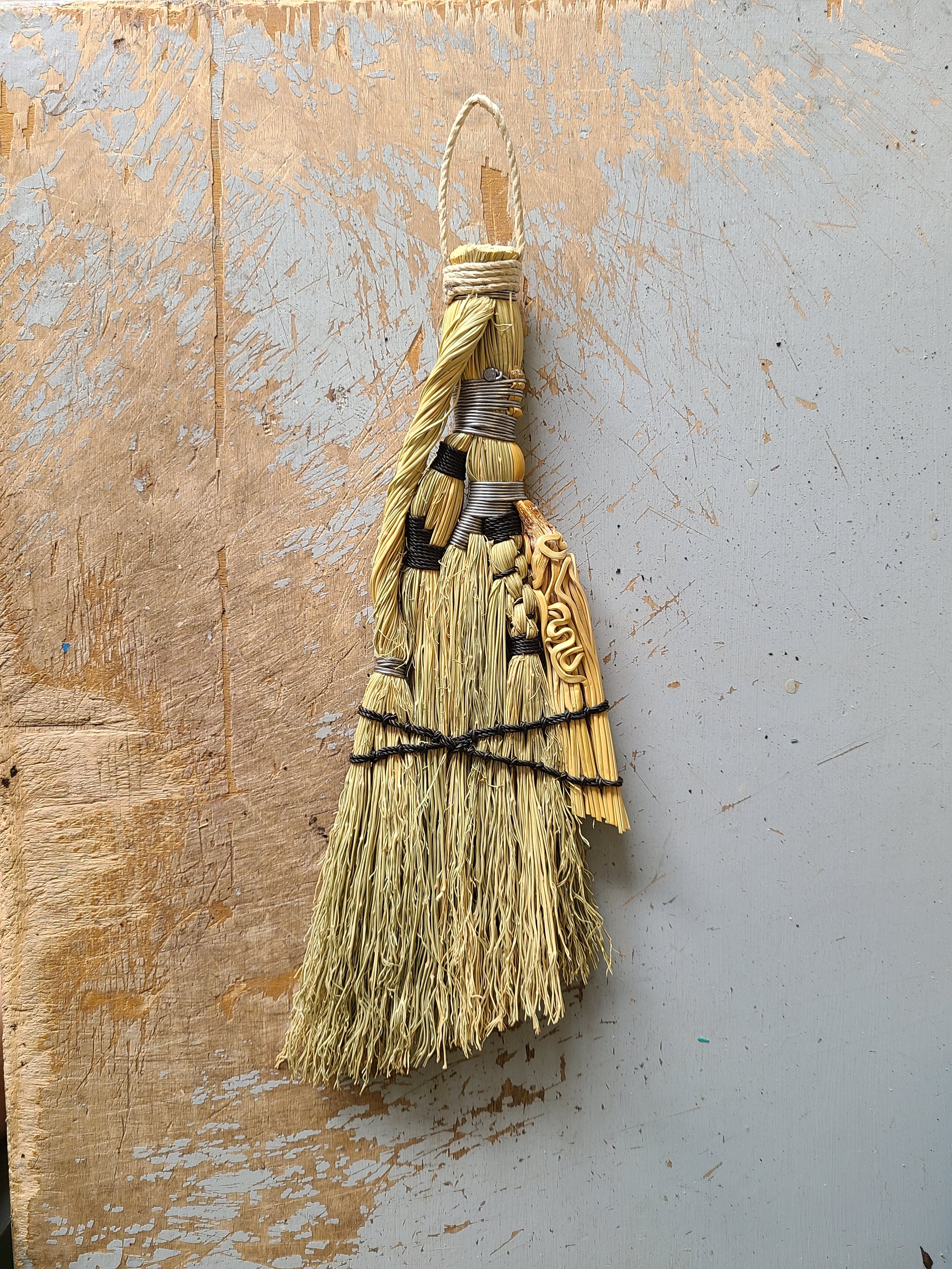
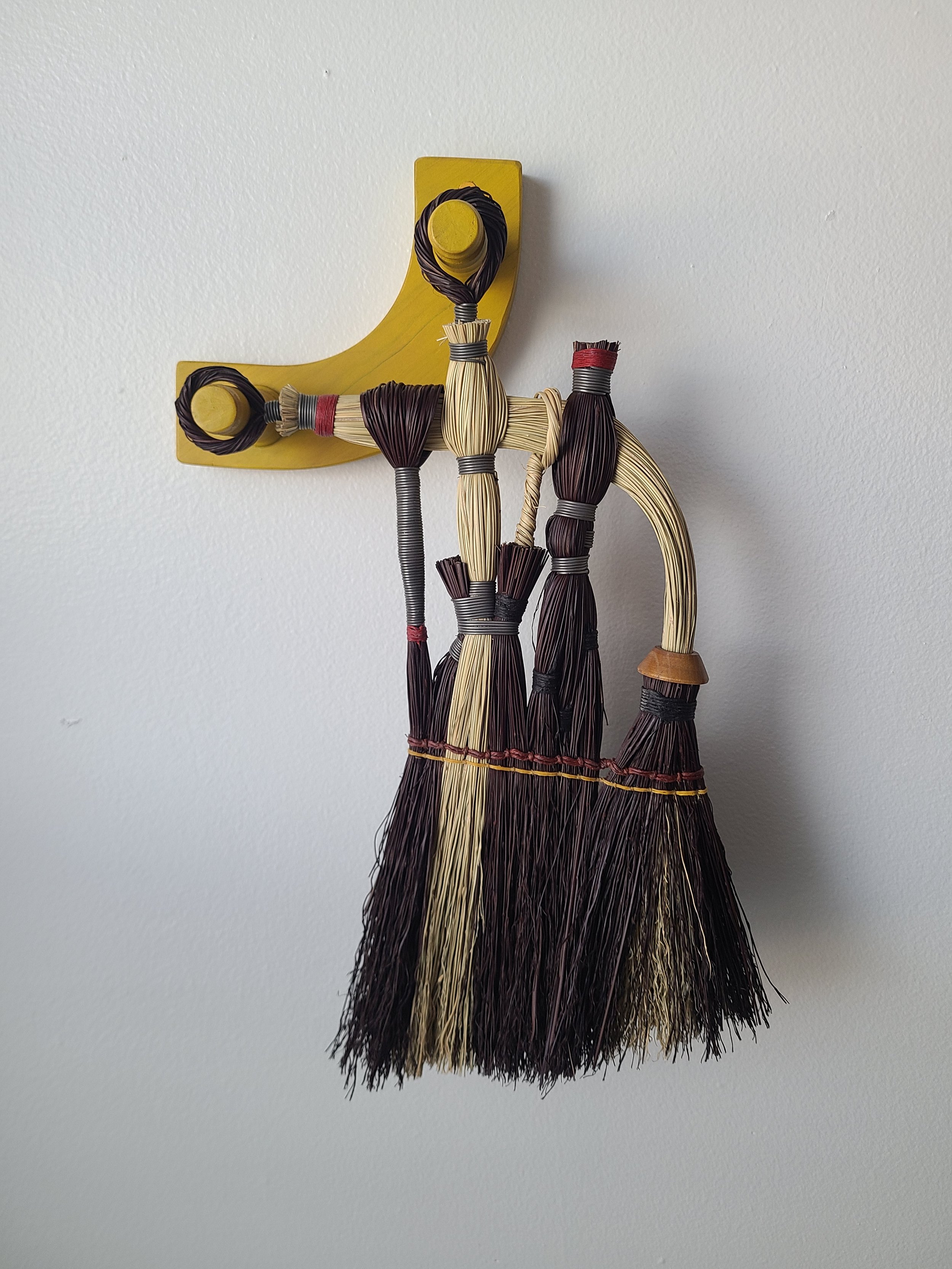
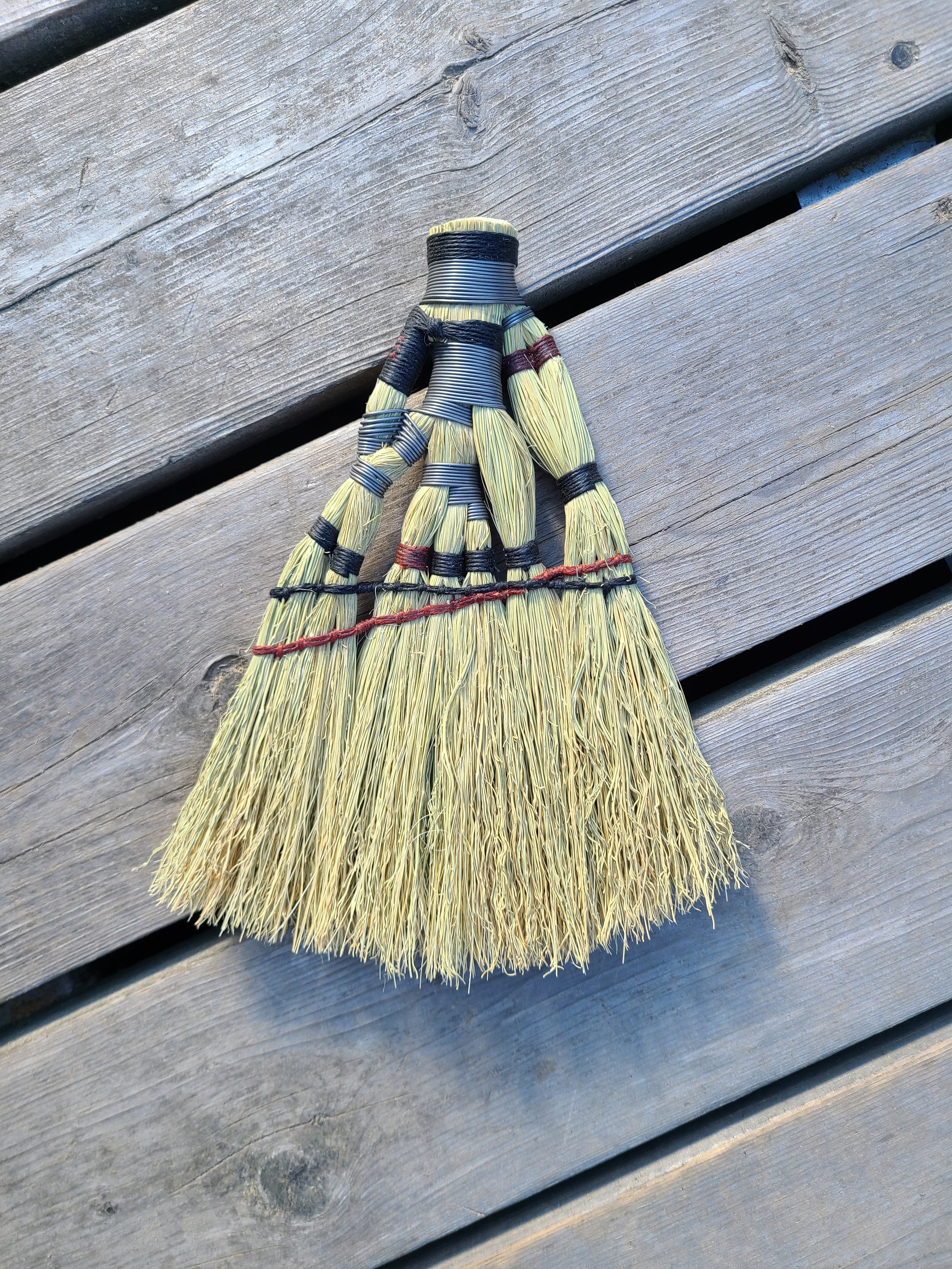
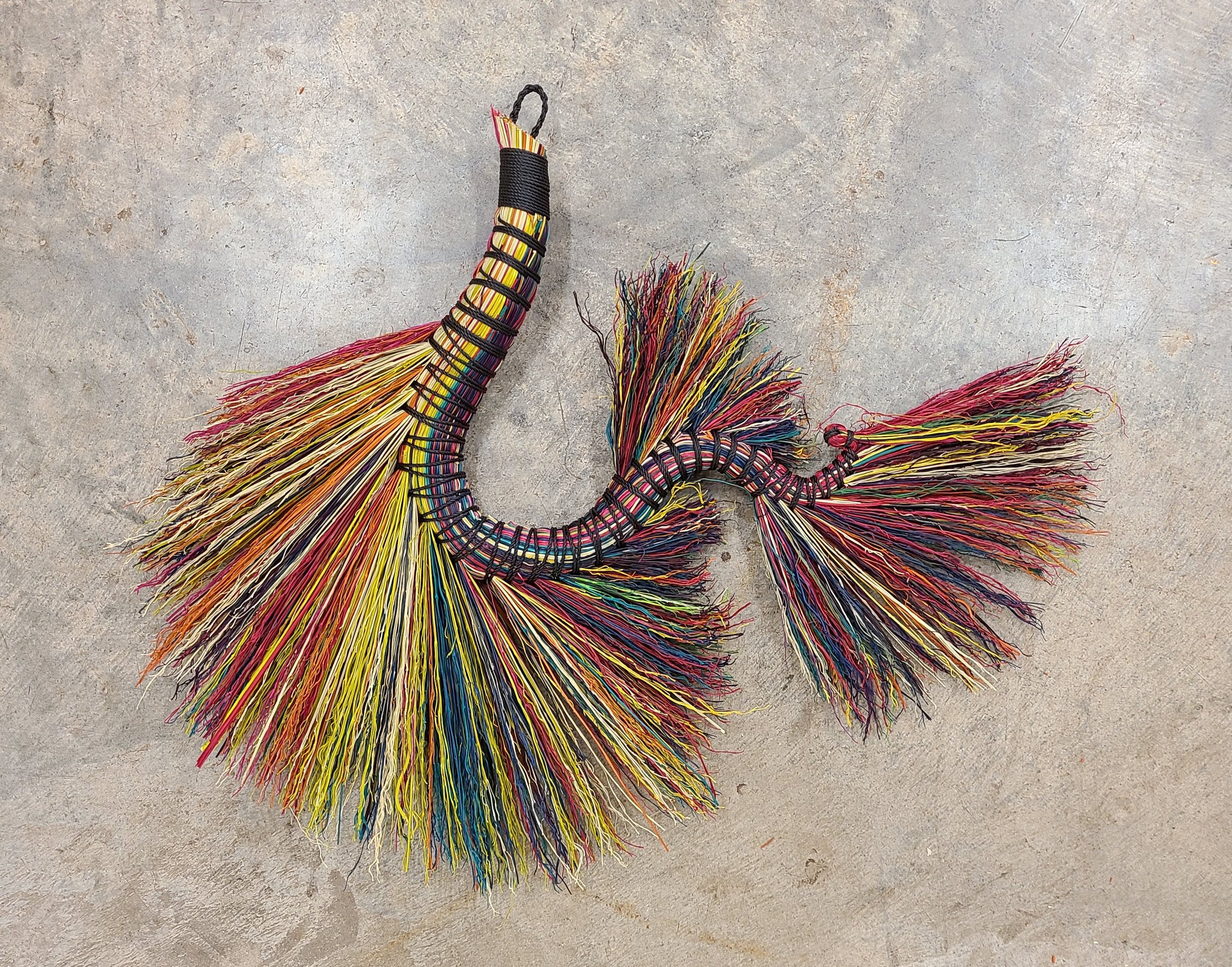
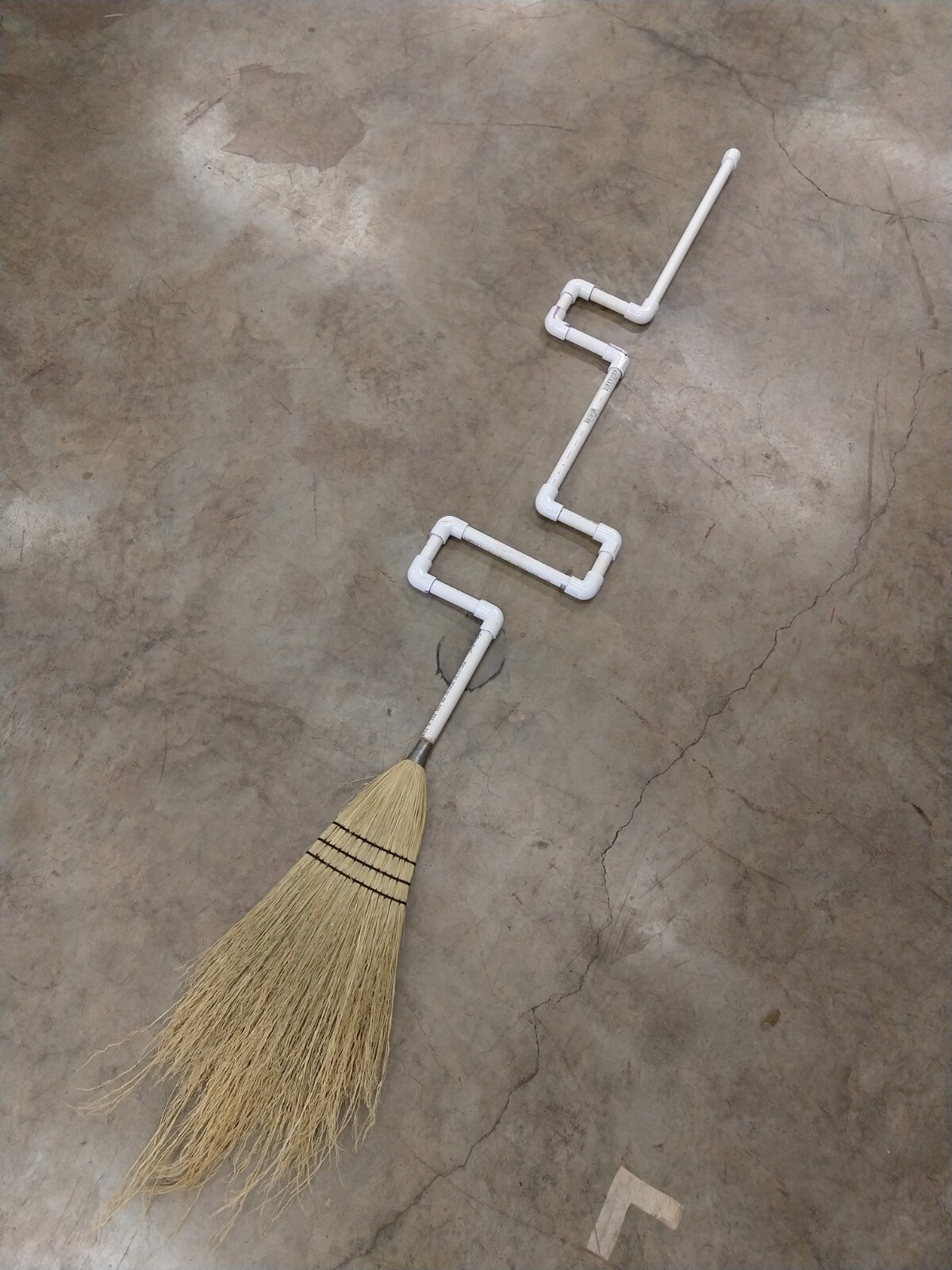
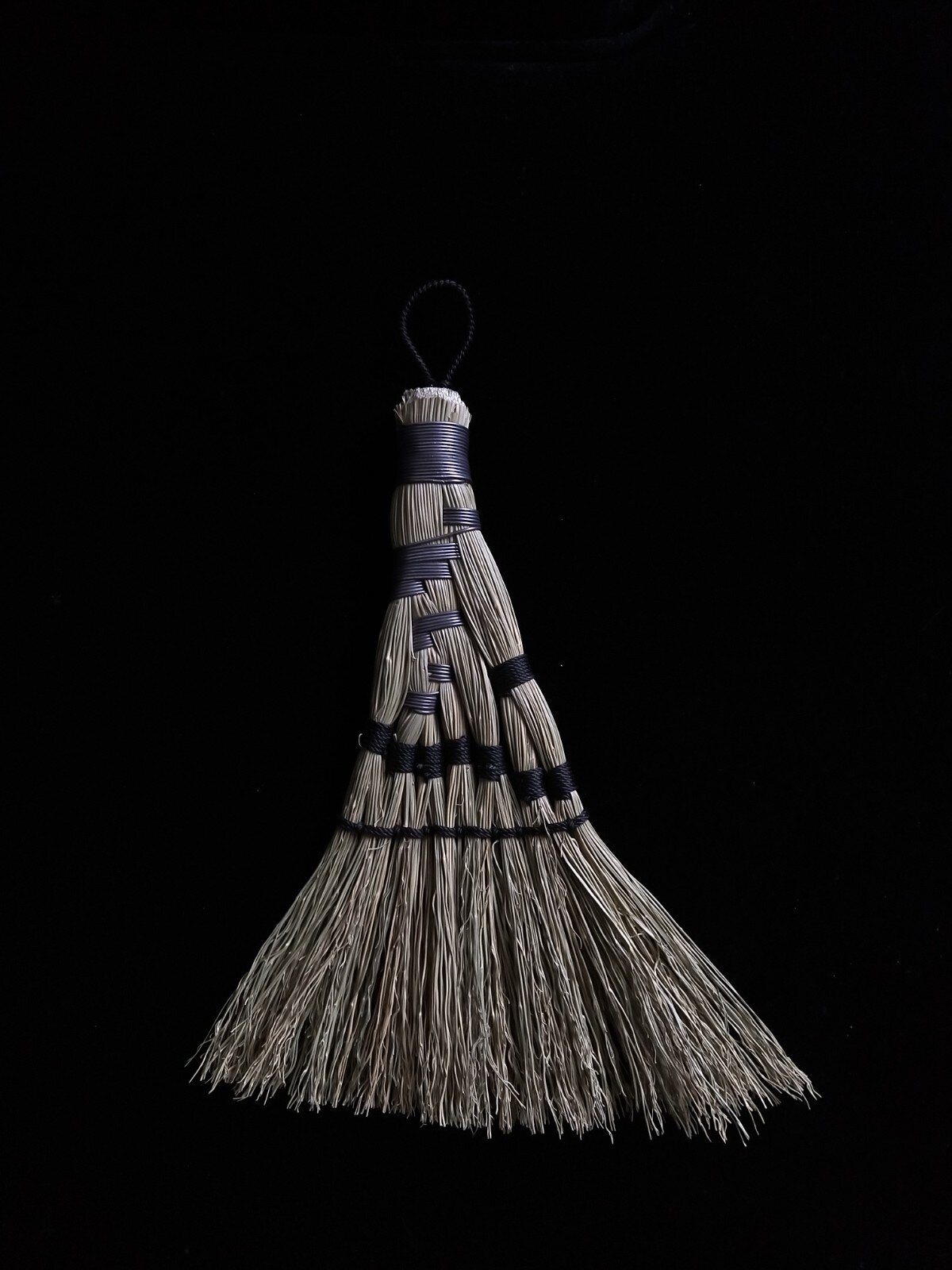
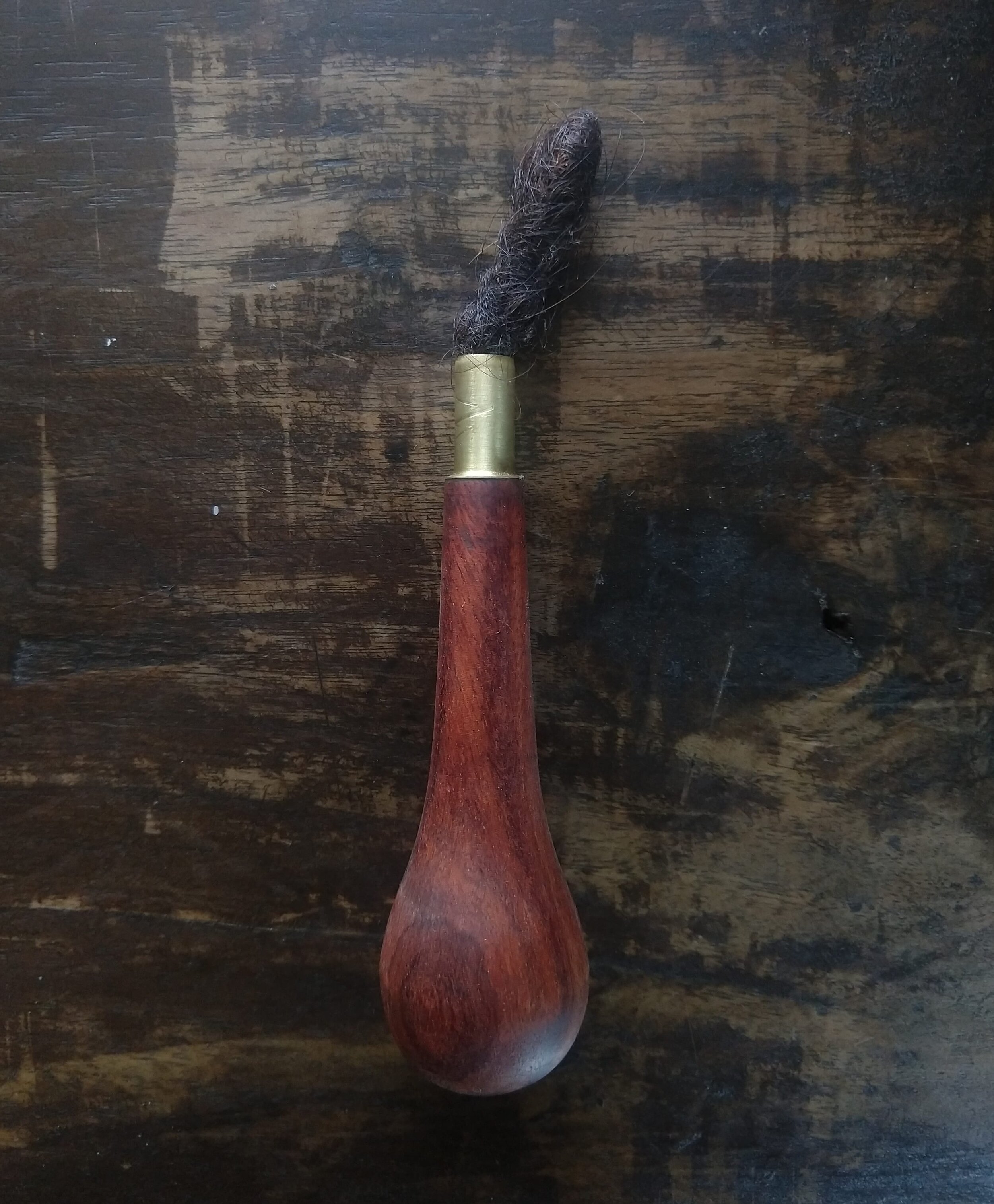
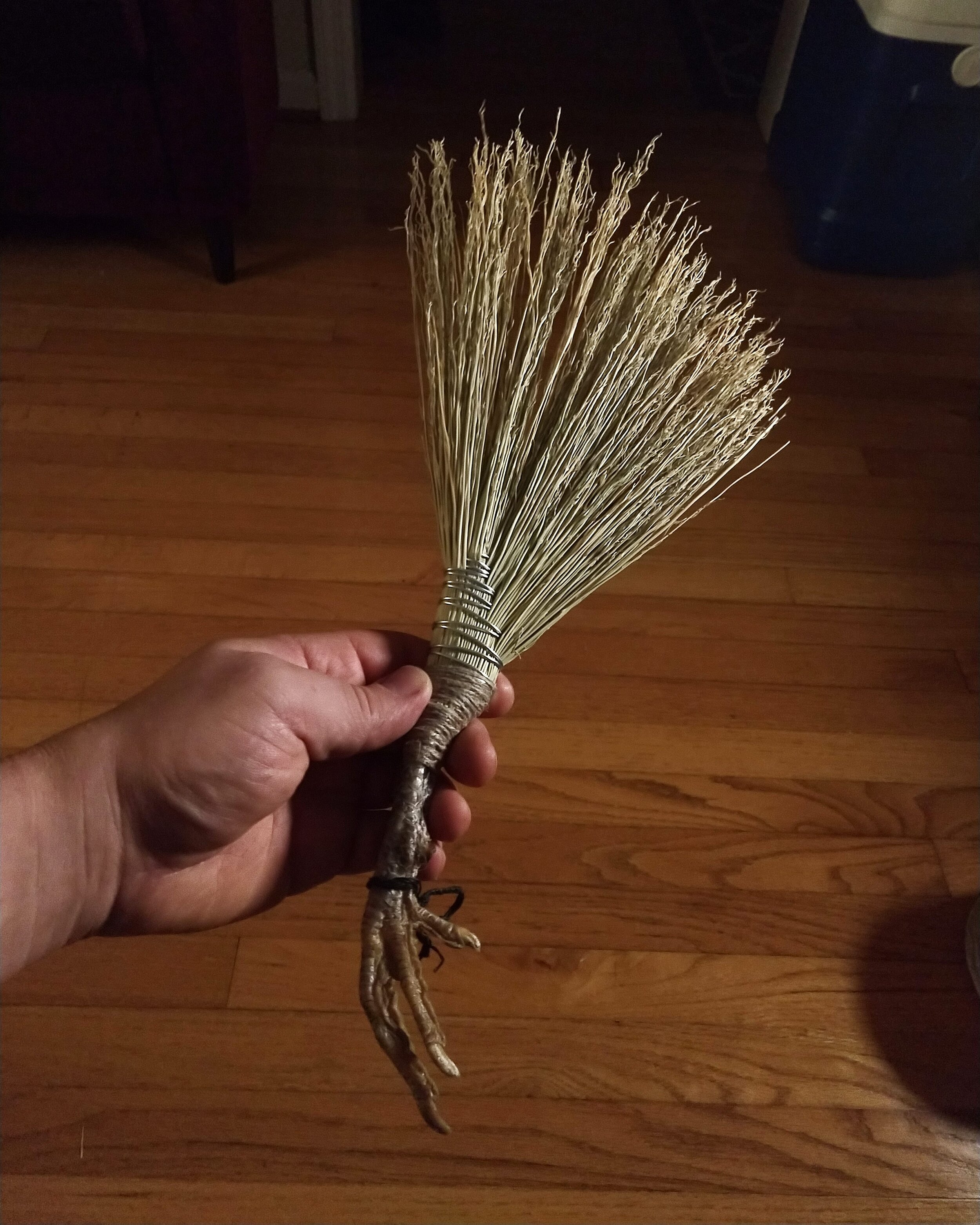
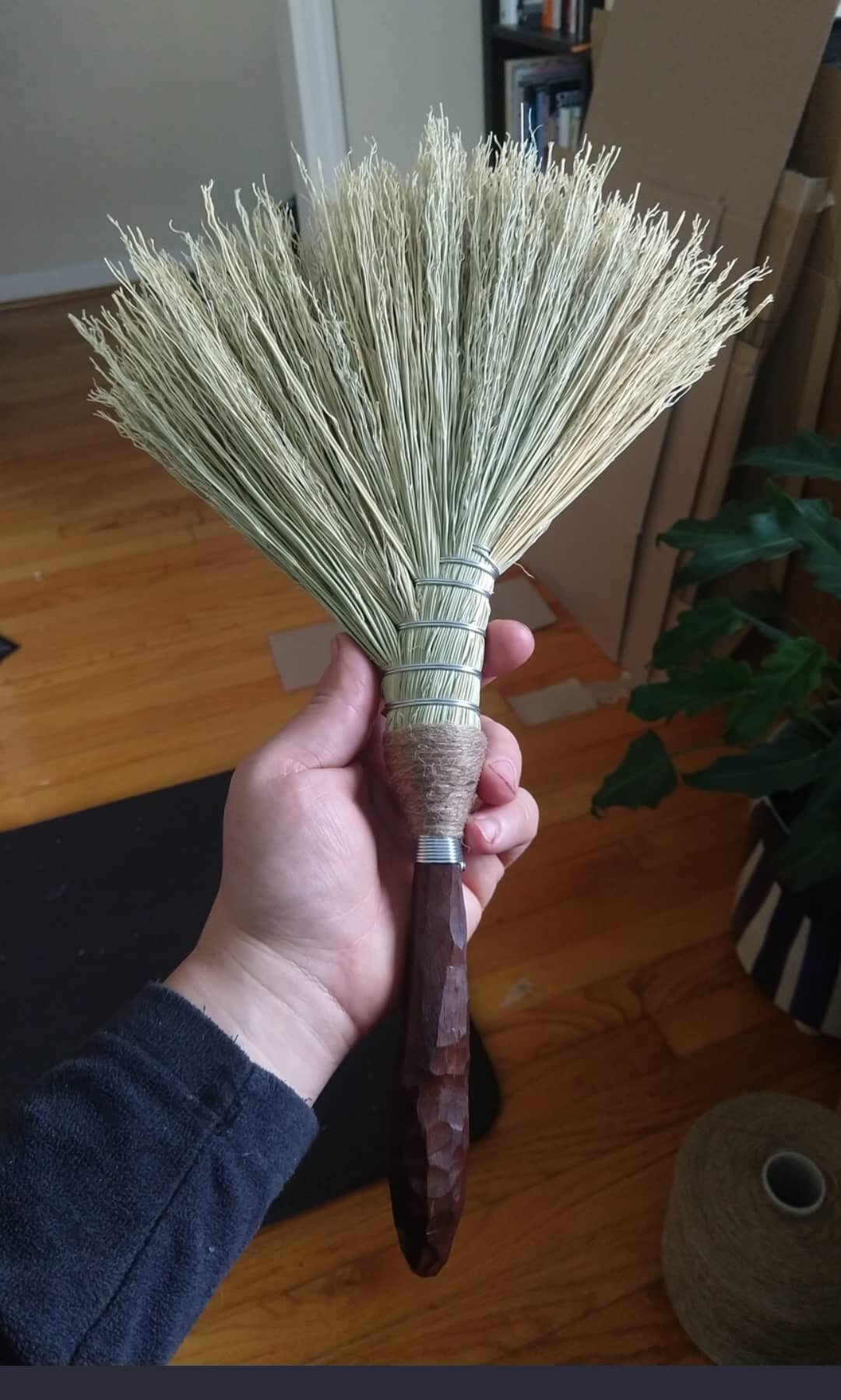
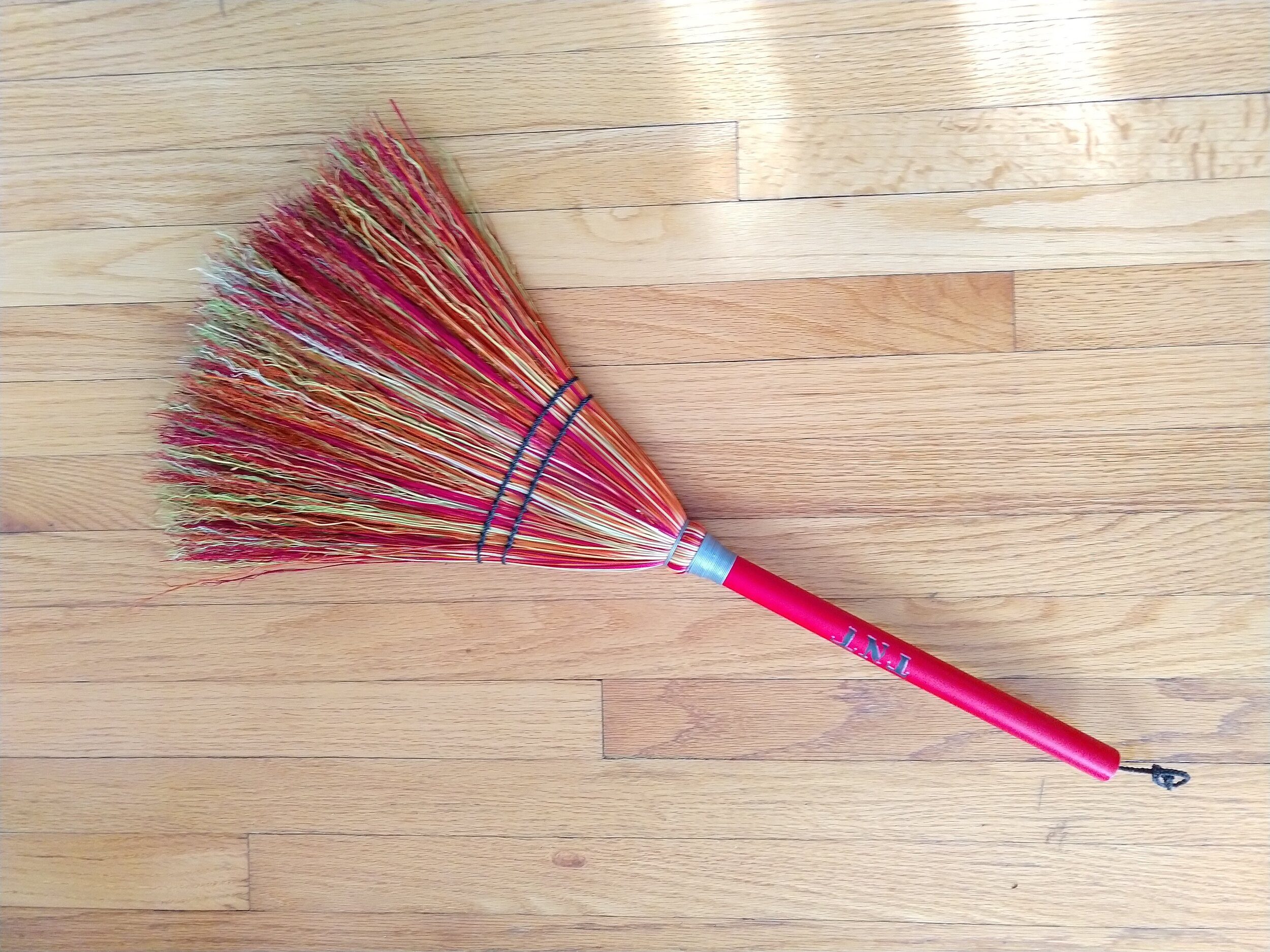
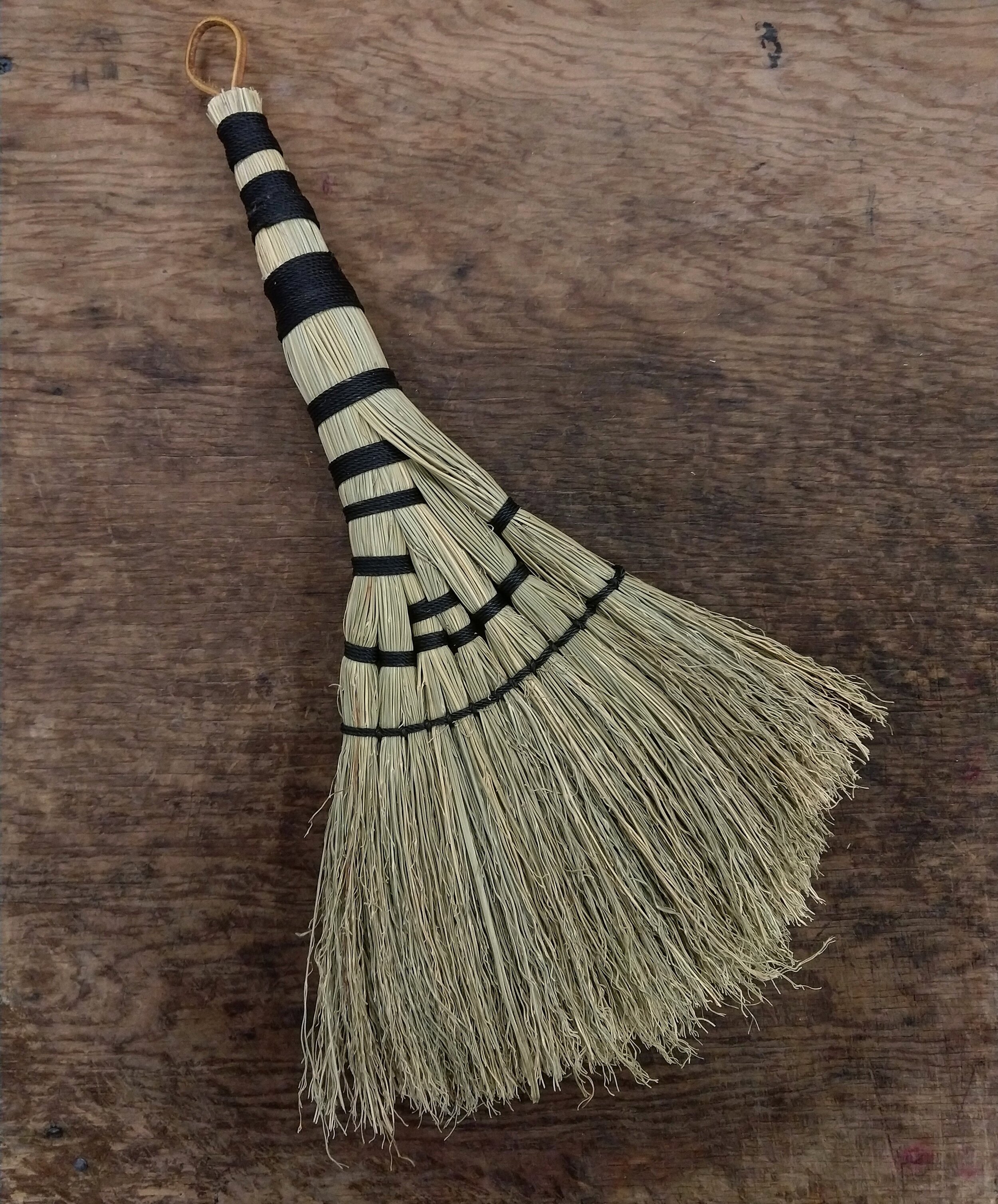
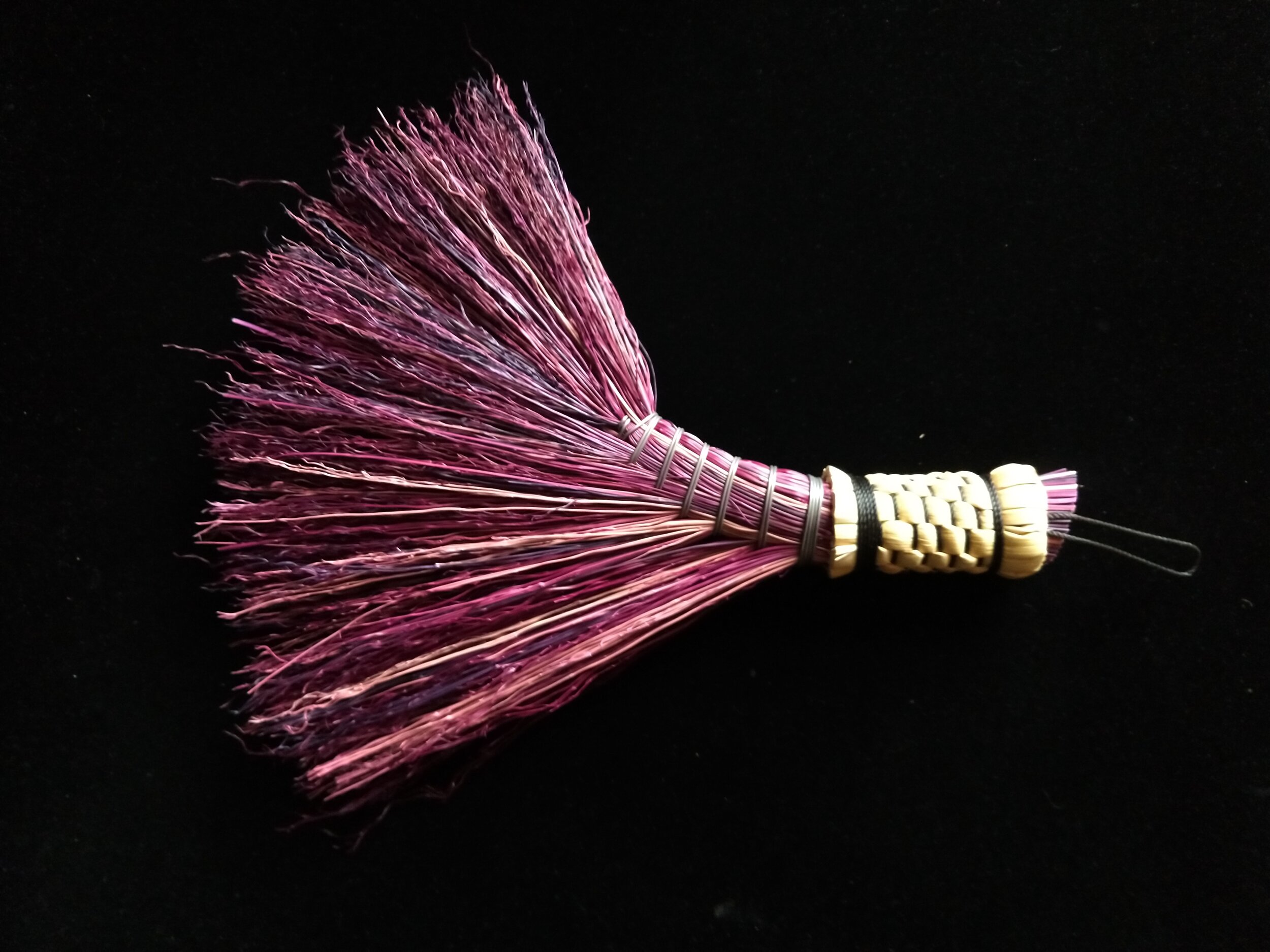
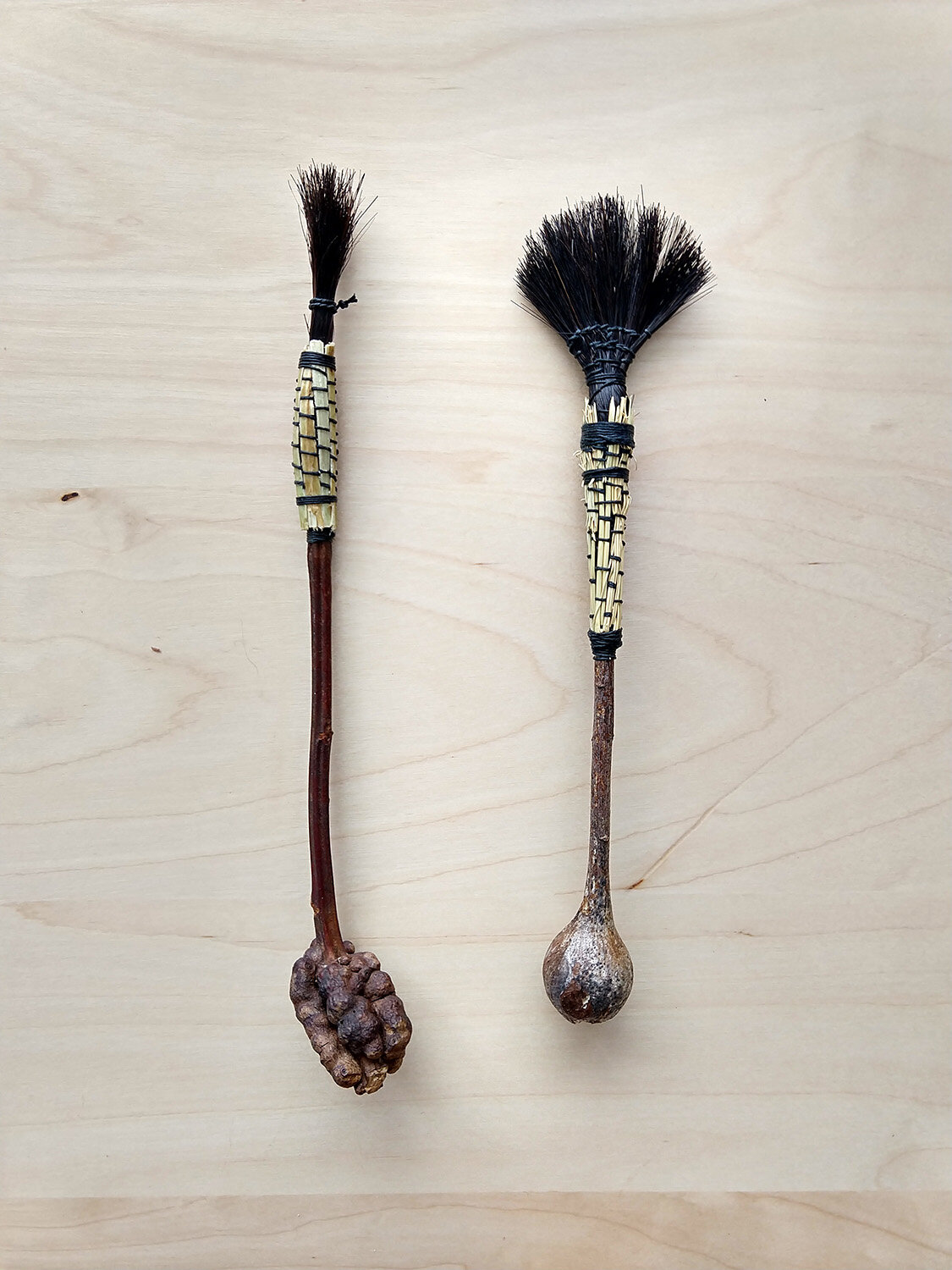
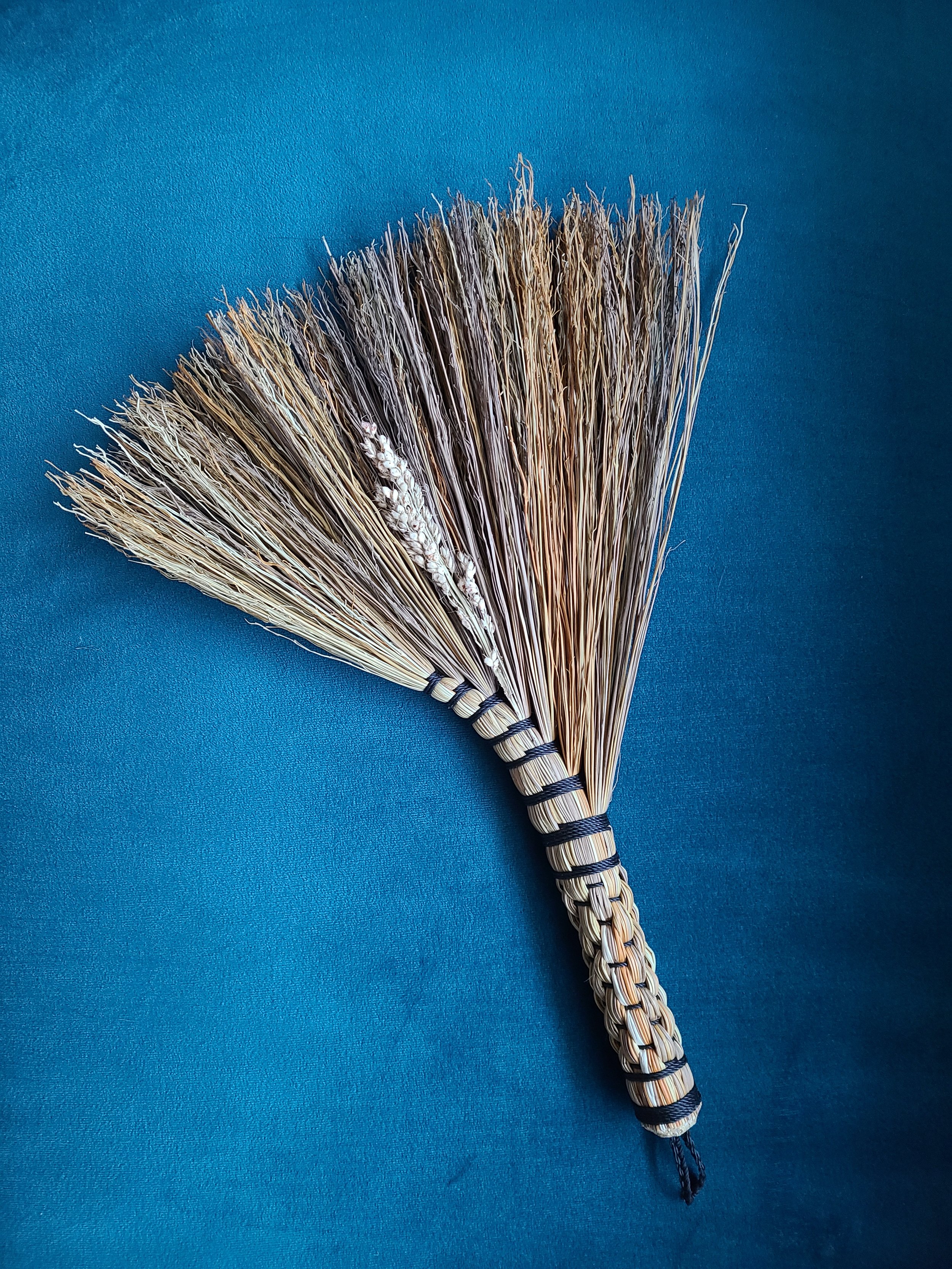
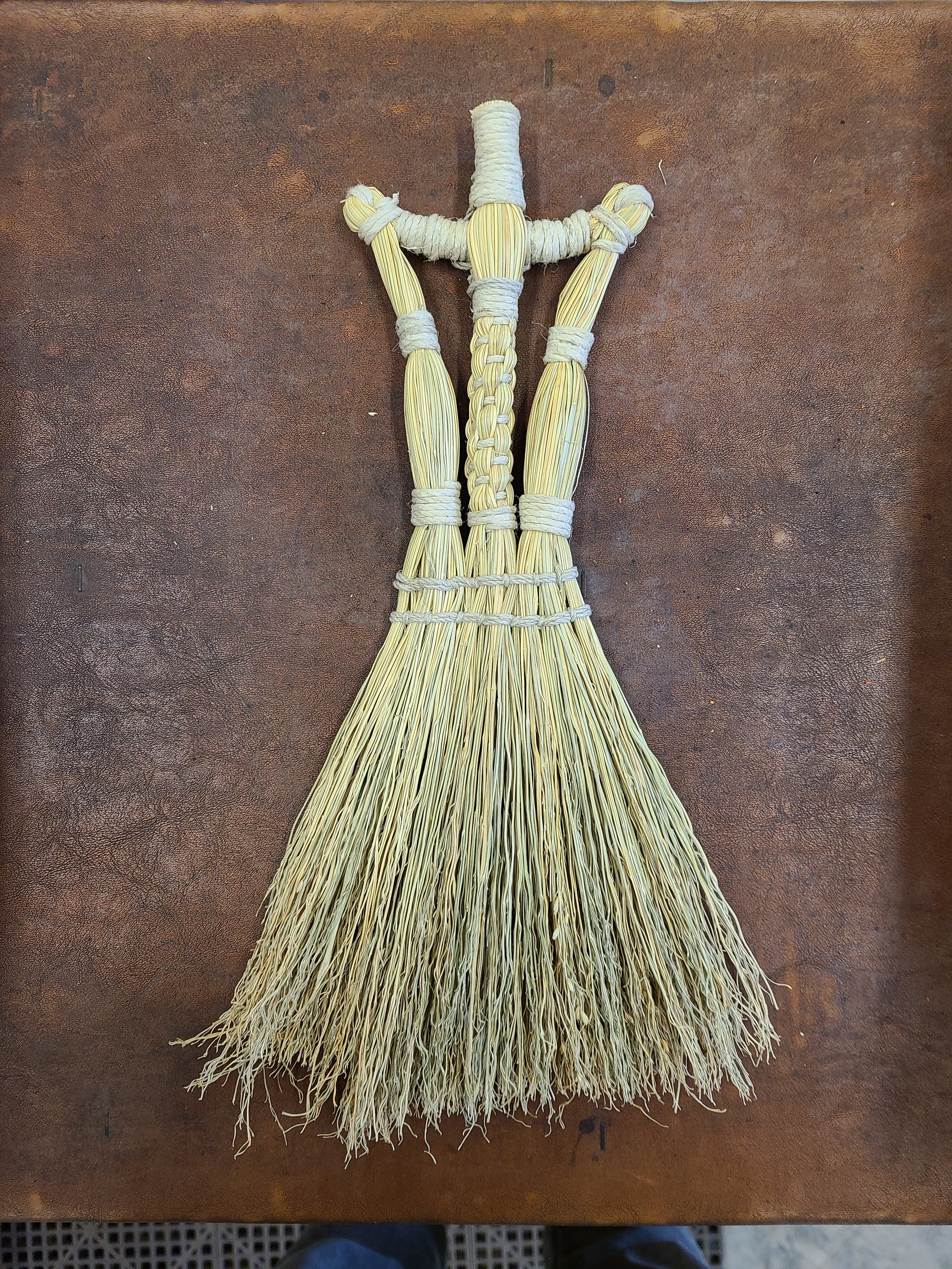

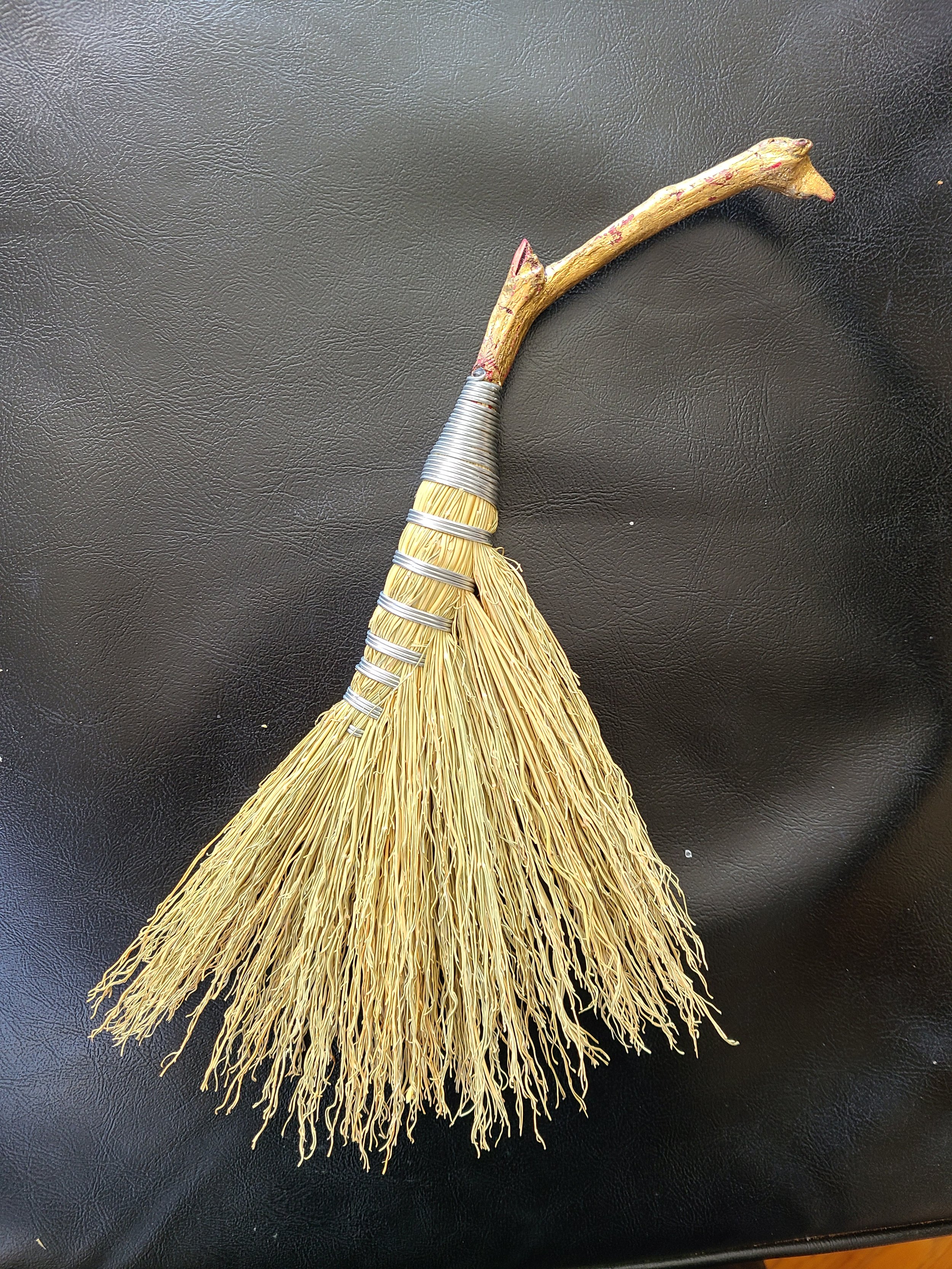
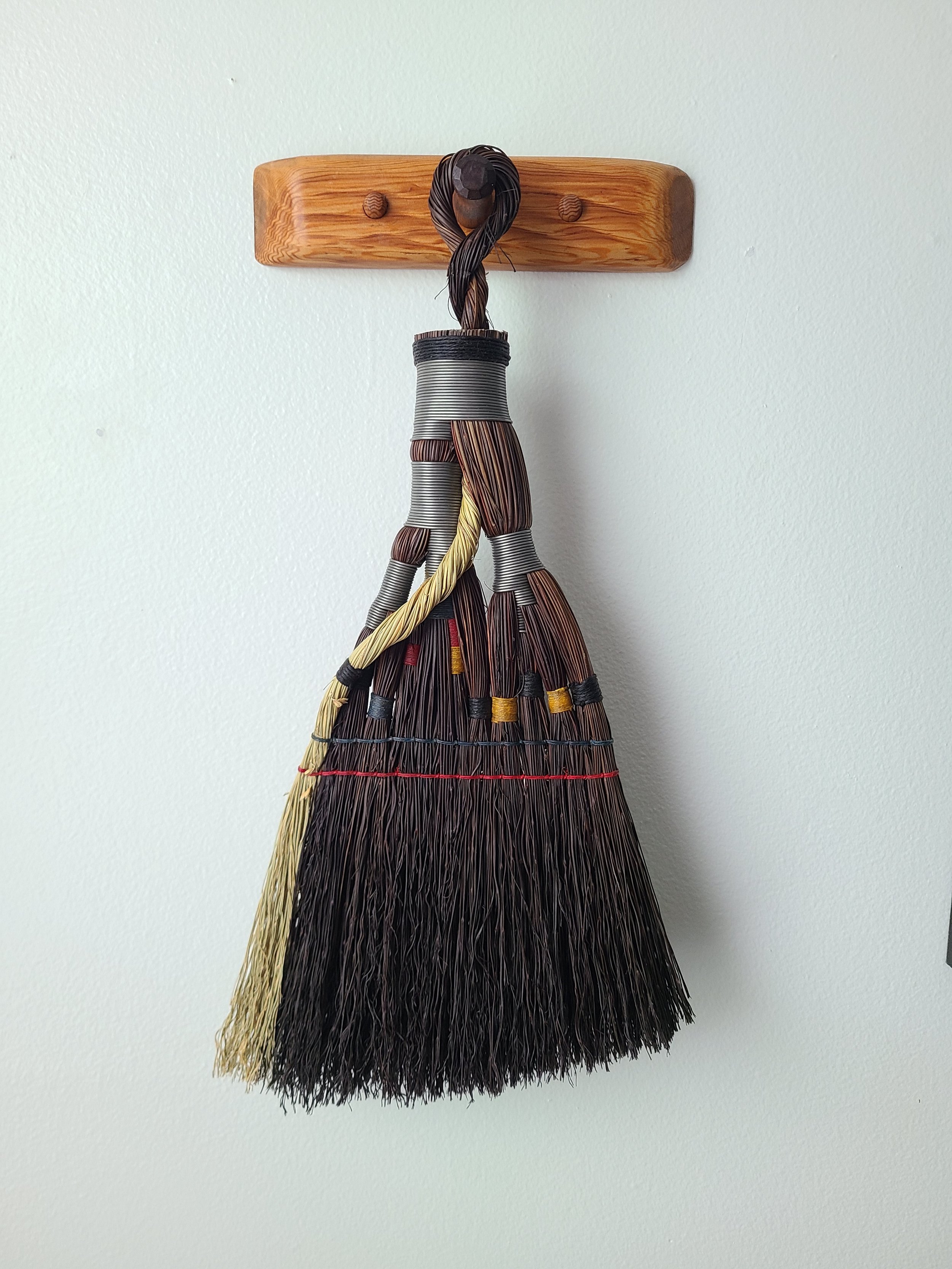
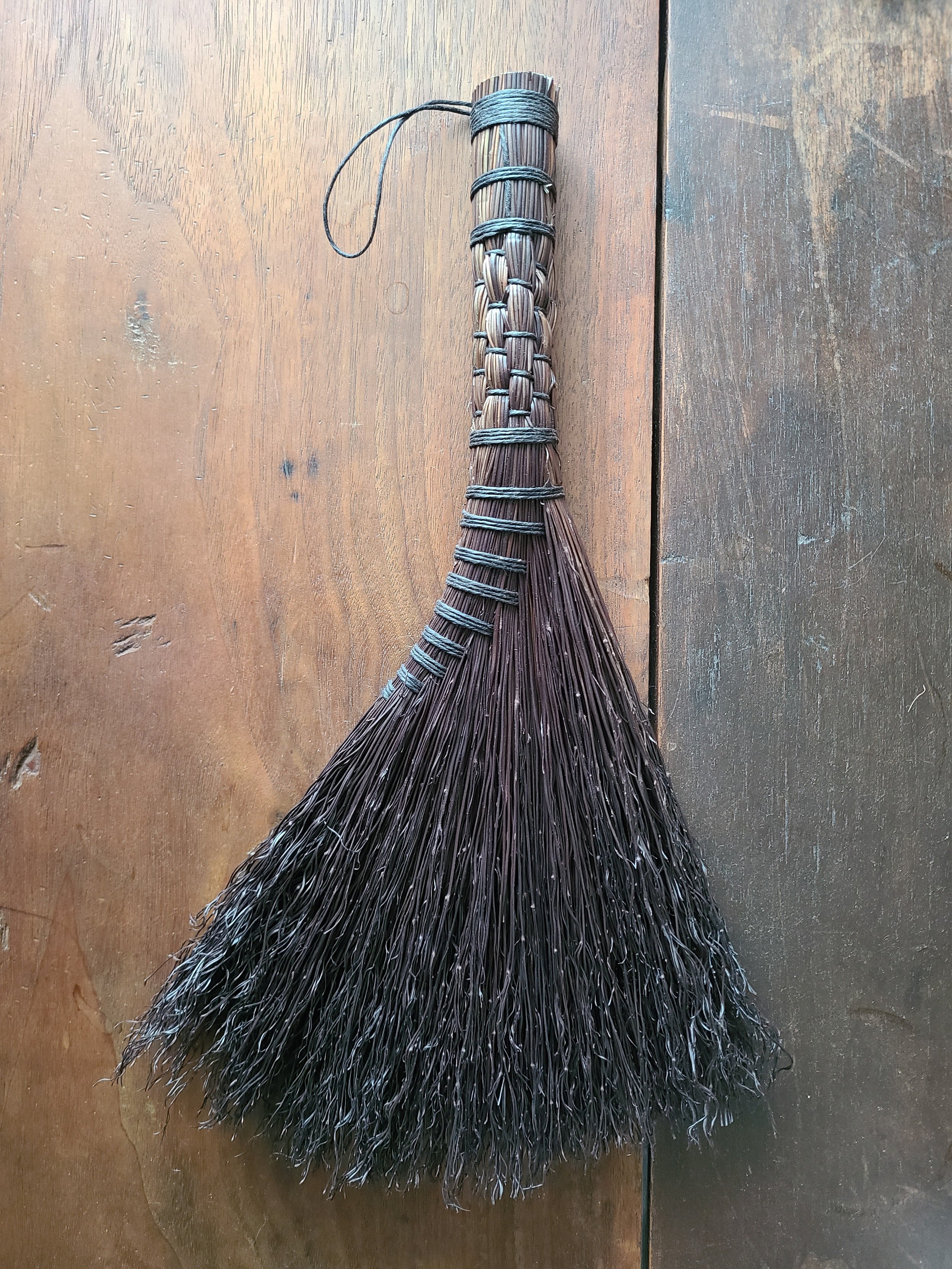
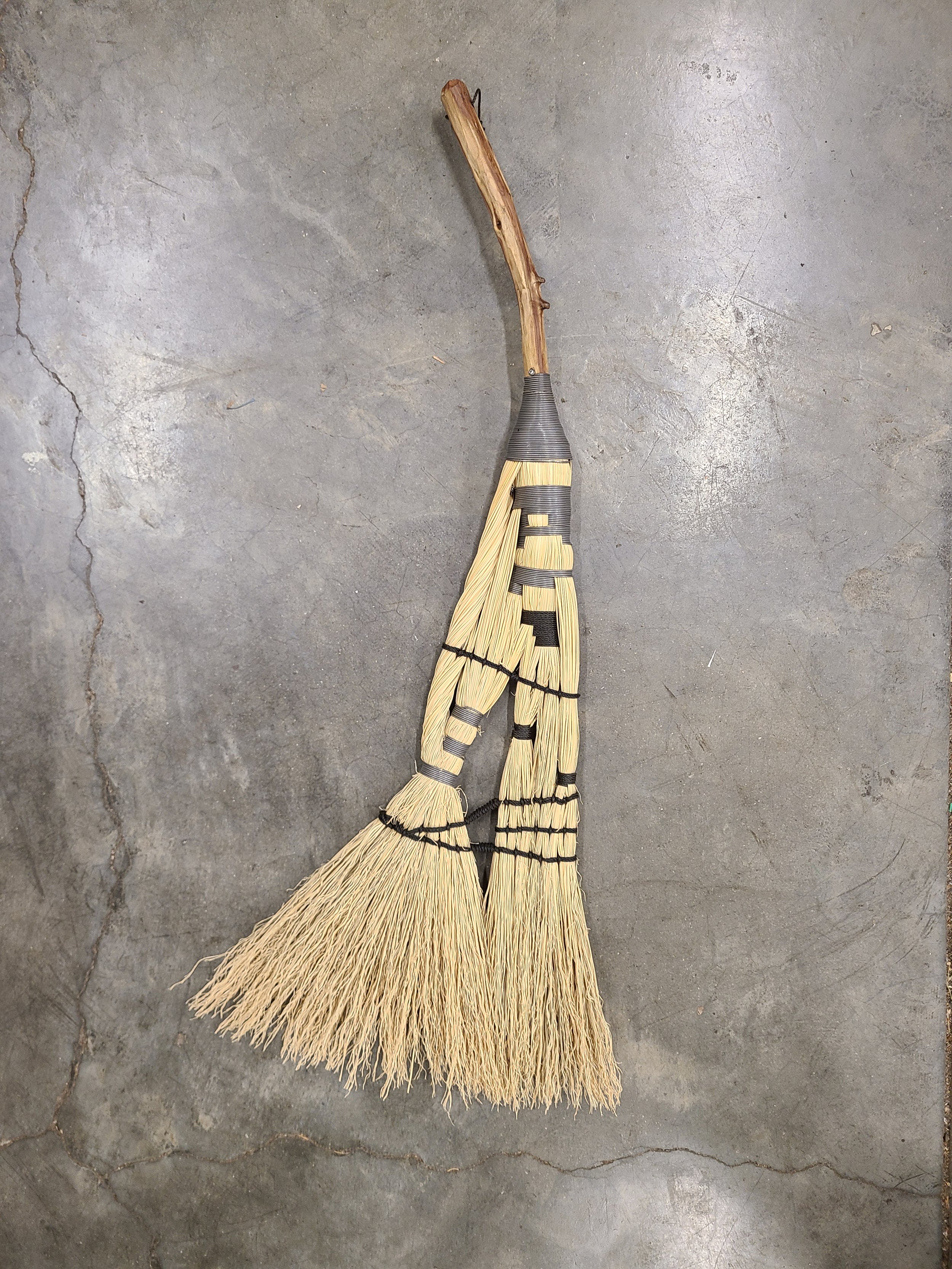
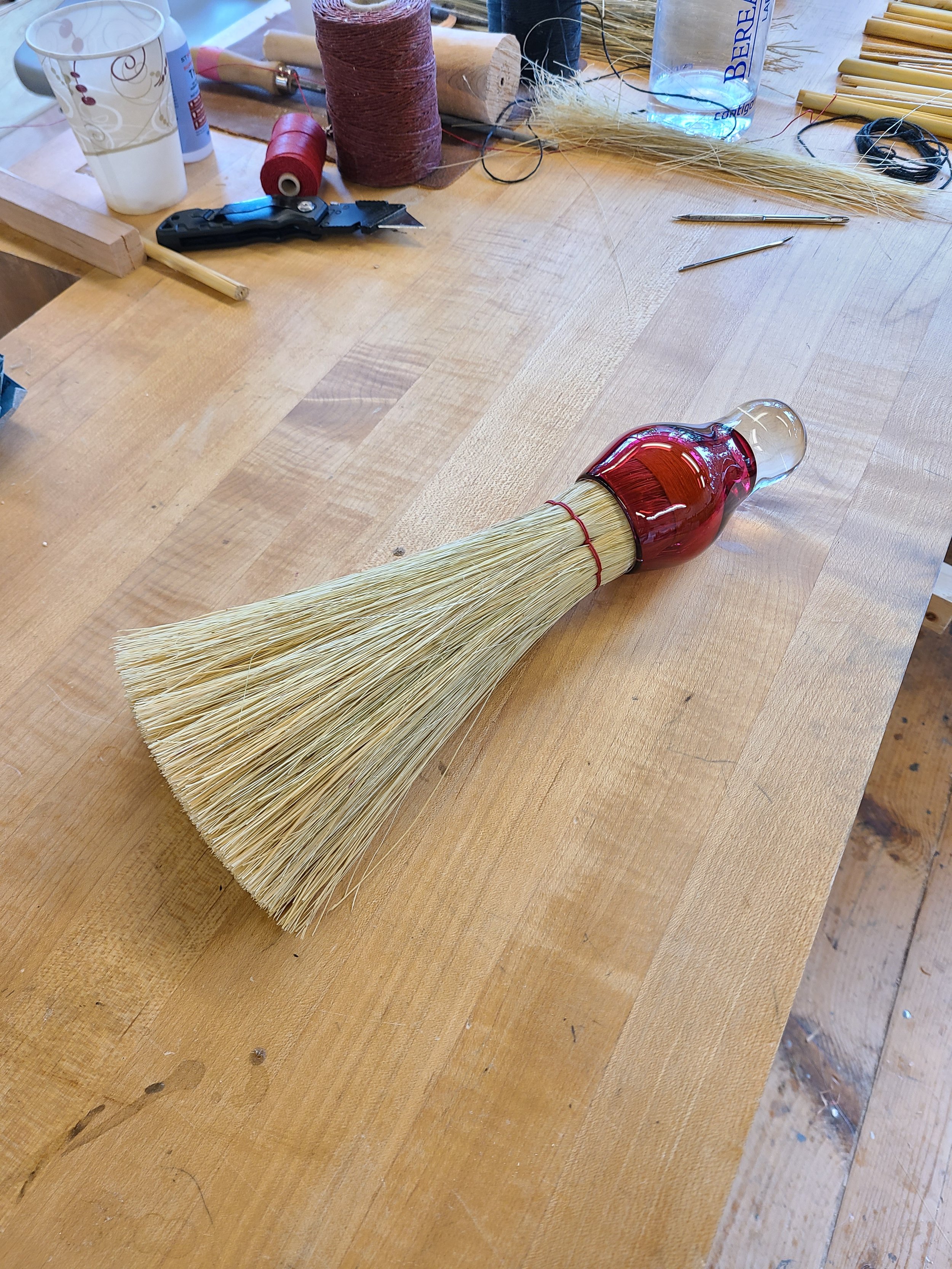
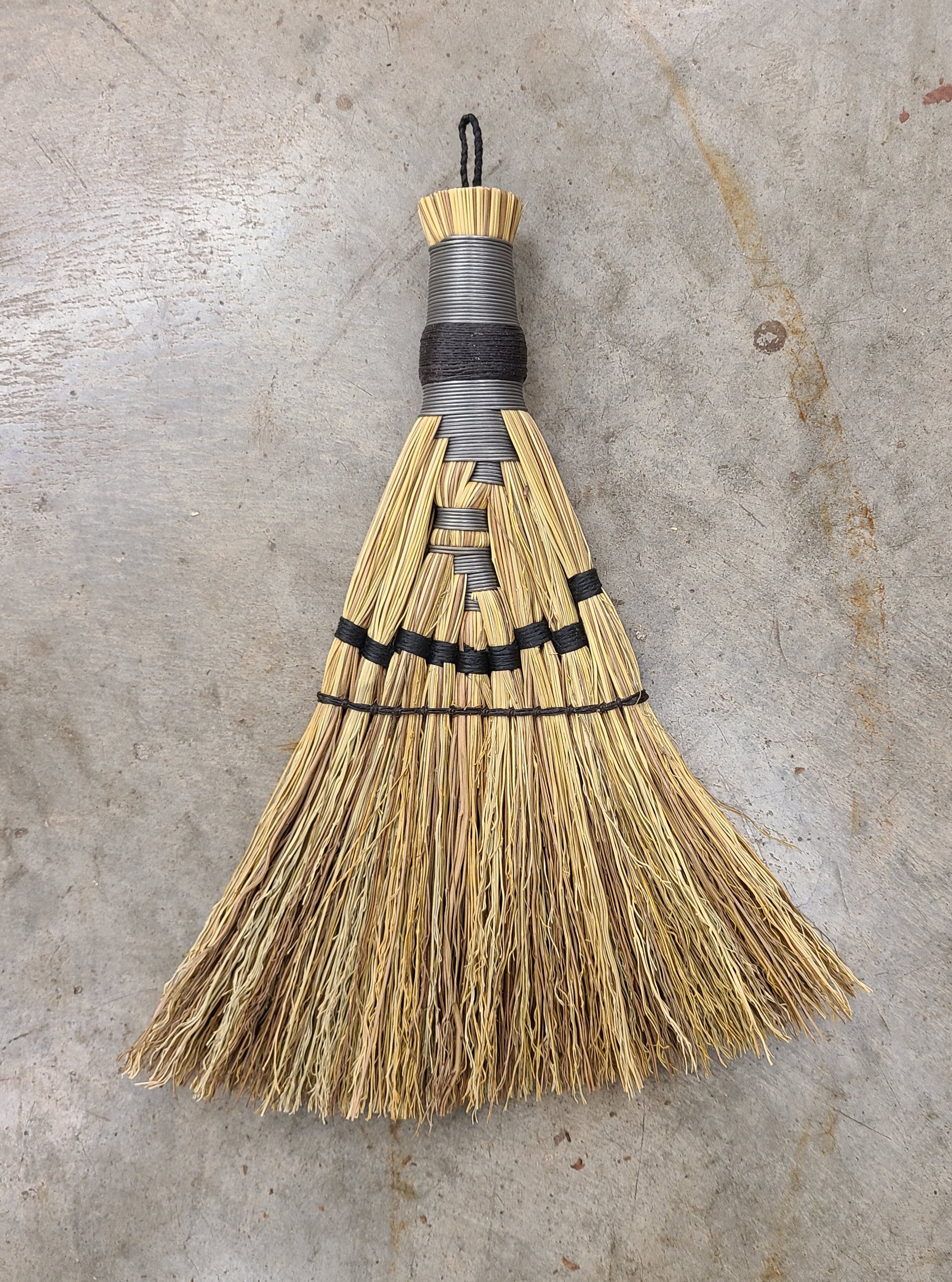
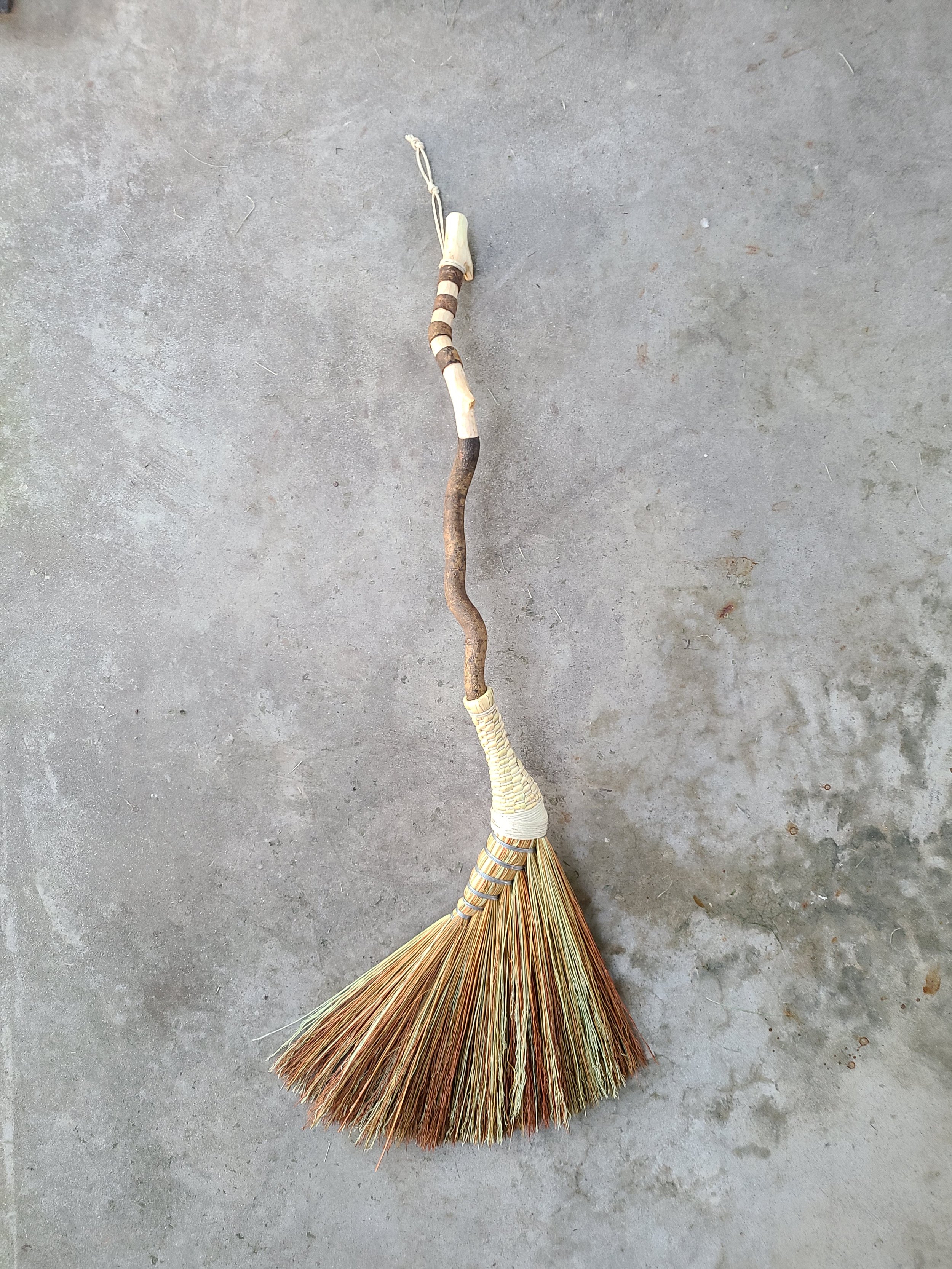



























Grab a Broom (With Me)
2023
Ebonized and natural ash wood, broomcorn, tinned broom wire, epoxy
Brooms are always present and rarely seen. To many, brooms have an interchangeable quality that allows them to hide in plain sight. Their classic, time-tested, and effective form enforces a broom’s utility and, in doing so, relegates them as simple, cheap tools for moving dirt. Just because something touches dirt doesn’t mean it shouldn’t be celebrated.
By tweaking forms and using traditional techniques where they would not normally be used, I have introduced asymmetry, negative space, and angular geometry where the broom would normally be smooth, dense, and even. Biomimicry is integrated as well, as it is in many traditional broom forms such as hawk tails and turkey wings, in this case from insects. The carved details on the broom handle are loosely based on patterns found on insect eggs and long, sharply bent angles of the broomcorn recall spider legs. The stand serves as a familial unifier, allowing the objects to hold hands.
Grab a Broom (With Me)
2023
Ebonized and natural ash wood, broomcorn, tinned broom wire, epoxy
Brooms are always present and rarely seen. To many, brooms have an interchangeable quality that allows them to hide in plain sight. Their classic, time-tested, and effective form enforces a broom’s utility and, in doing so, relegates them as simple, cheap tools for moving dirt. Just because something touches dirt doesn’t mean it shouldn’t be celebrated.By tweaking forms and using traditional techniques where they would not normally be used, I have introduced asymmetry, negative space, and angular geometry where the broom would normally be smooth, dense, and even. Biomimicry is integrated as well, as it is in many traditional broom forms such as hawk tails and turkey wings, in this case from insects. The carved details on the broom handle are loosely based on patterns found on insect eggs and long, sharply bent angles of the broomcorn recall spider legs. The stand serves as a familial unifier, allowing the objects to hold hands.
Hunter L.V. ElliottTrochanter Broom with StandBroom: Broomcorn, tin wire, carved Osage orange nail, hemp chord, red oak, glue Stand: red maple, red oak, Danish oil, walnut pigment, walnut oil, glue2022Available for purchase at Log House Craft Gallery, Berea, KYA main component of my work is allowing material within a piece to be visible. I like to show my process and let the materials speak for themselves. Within most full-sized brooms, many internal components are invisible from the outside. Much goes into the construction of the deceivingly complicated object that is hidden from the user to produce a simple, effective, and functional form. In making this work, I challenged myself to create a broom that pushes the boundaries of what is physically possible with the natural materials traditionally used to make brooms, all while making a striking yet functional piece.By combining different construction tactics that I’ve adapted from commonly used designs in American and Japanese broom making, this broom stands full of intricate details. Its grand scale is broken up by windows of negative space that give the for room to breathe, but also demonstrate the immense tension that the broomcorn was subjected to in order to achieve the bends and pulls that make the shape. From the front view, it resembles a flat plane, with vertical and horizontal arms that weave over and under each other, conjuring an anthropomorphic, insect-like condition. This inspired the title for the piece, Trochanter, referring to the joints in spider’s legs. From the sides,this view is made even more clear by the alternating joints of each bundle, lacing then cascading groundward. Even the innermost core of the broom, an area that is never seen on a Western style broom, can be seen through the edges of the central portion of broomcorn. This broom is unique in the amount of texture it has from every angle. There is hard and soft geometry to be seen regardless of the perspective it is seen from.The broom is bundled and finished in wire, and that wire is finished with a nail, hand carved from Osage heartwood, one of the hardest and most rot resistant woods in North America - unlike the oak handle, which exhibits decay and holes from boring beetles. All the wood featured in the piece was sustainably sourced from the Berea College Forest and campus. The stand which holds the broom is made from red maple, an invasive species in this region. Removal of these saplings was a service to the land by allowing the understory to receive more light and giving slower-growing flora the opportunity to thrive. The symbolic act of using this invasive tree to uphold a rotted limb of an oak subverts this relationship. The stand is stained using walnut pigment, harvested from walnuts from the Berea campus and mixed with a walnut oil base.Brooms hold a special place within humanity. They exist everywhere that humans exist in one form or another, and every population has their own approach to the craft.Brooms appear as symbols in political campaigns and cartoons, as ceremonial objects,as good omens in some cases and bad omens in others. They are thought to strengthen, hurt, or even prevent relationships altogether depending on their use.They have their own etiquette that shifts regionally- when to use them, how to store them, and why. Brooms and their spiritual attributions encapsulate the creation of meaning. That meaning assigned to an inanimate object is reflective of one’s culture,experience, and geographical location. It can seem arbitrary and at times contradictory.Why should something that comes in contact with dirt have a central role in ceremony?The British anthropologist Mary Douglas made famous the phrase “Dirt is matter out of place.” This assertion gives agency to the common derogatory term dirt. Suddenly, dirt isn’t waste, but rather simply material – substance without social connotation. A common theme within many cultures in relation to brooms is their ability to clean,physically, but also spiritually. If Douglas’s perspective shift is applied to these cultural connotations, the broom as a tool to usher away bad luck and to attract good luck makes much more sense. Recognizing that an object means different things in different places erases those superficial contradictions. The broom becomes a neutral vessel. It is a tool capable of exerting force and intention in the direction one chooses. The“matter” either moved or held in this case could be luck, energy, a relationship, a connection to one’s environment, or any other meaning.From a secular perspective, to acknowledge intention, and act in that direction could be a personal ceremony or meditation. I made this broom with environmental concerns and artistic forms in mind - that is my meditation. It allowed me to reflect, and to distill my intentions. It allowed me to create a form and ascribe meaning to it. It allowed me to move some theoretical matter of my own.
Hunter L.V. Elliott
Trochanter Broom with Stand
Broom: Broomcorn, tin wire, carved Osage orange nail, hemp chord, red oak, glue
Stand: red maple, red oak, Danish oil, walnut pigment, walnut oil, glue2022
Available for purchase at Log House Craft Gallery, Berea, KY
A main component of my work is allowing material within a piece to be visible. I like to show my process and let the materials speak for themselves. Within most full-sized brooms, many internal components are invisible from the outside. Much goes into the construction of the deceivingly complicated object that is hidden from the user to produce a simple, effective, and functional form. In making this work, I challenged myself to create a broom that pushes the boundaries of what is physically possible with the natural materials traditionally used to make brooms, all while making a striking yet functional piece.By combining different construction tactics that I’ve adapted from commonly used designs in American and Japanese broom making, this broom stands full of intricate details. Its grand scale is broken up by windows of negative space that give the for room to breathe, but also demonstrate the immense tension that the broomcorn was subjected to in order to achieve the bends and pulls that make the shape. From the front view, it resembles a flat plane, with vertical and horizontal arms that weave over and under each other, conjuring an anthropomorphic, insect-like condition. This inspired the title for the piece, Trochanter, referring to the joints in spider’s legs. From the sides,this view is made even more clear by the alternating joints of each bundle, lacing then cascading groundward. Even the innermost core of the broom, an area that is never seen on a Western style broom, can be seen through the edges of the central portion of broomcorn. This broom is unique in the amount of texture it has from every angle. There is hard and soft geometry to be seen regardless of the perspective it is seen from.The broom is bundled and finished in wire, and that wire is finished with a nail, hand carved from Osage heartwood, one of the hardest and most rot resistant woods in North America - unlike the oak handle, which exhibits decay and holes from boring beetles. All the wood featured in the piece was sustainably sourced from the Berea College Forest and campus. The stand which holds the broom is made from red maple, an invasive species in this region. Removal of these saplings was a service to the land by allowing the understory to receive more light and giving slower-growing flora the opportunity to thrive. The symbolic act of using this invasive tree to uphold a rotted limb of an oak subverts this relationship. The stand is stained using walnut pigment, harvested from walnuts from the Berea campus and mixed with a walnut oil base.Brooms hold a special place within humanity. They exist everywhere that humans exist in one form or another, and every population has their own approach to the craft.Brooms appear as symbols in political campaigns and cartoons, as ceremonial objects,as good omens in some cases and bad omens in others. They are thought to strengthen, hurt, or even prevent relationships altogether depending on their use.They have their own etiquette that shifts regionally- when to use them, how to store them, and why. Brooms and their spiritual attributions encapsulate the creation of meaning. That meaning assigned to an inanimate object is reflective of one’s culture,experience, and geographical location. It can seem arbitrary and at times contradictory.Why should something that comes in contact with dirt have a central role in ceremony?The British anthropologist Mary Douglas made famous the phrase “Dirt is matter out of place.” This assertion gives agency to the common derogatory term dirt. Suddenly, dirt isn’t waste, but rather simply material – substance without social connotation. A common theme within many cultures in relation to brooms is their ability to clean,physically, but also spiritually. If Douglas’s perspective shift is applied to these cultural connotations, the broom as a tool to usher away bad luck and to attract good luck makes much more sense. Recognizing that an object means different things in different places erases those superficial contradictions. The broom becomes a neutral vessel. It is a tool capable of exerting force and intention in the direction one chooses. The“matter” either moved or held in this case could be luck, energy, a relationship, a connection to one’s environment, or any other meaning.From a secular perspective, to acknowledge intention, and act in that direction could be a personal ceremony or meditation. I made this broom with environmental concerns and artistic forms in mind - that is my meditation. It allowed me to reflect, and to distill my intentions. It allowed me to create a form and ascribe meaning to it. It allowed me to move some theoretical matter of my own.